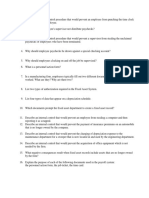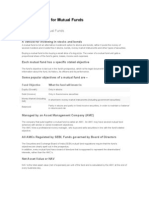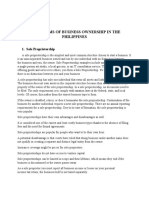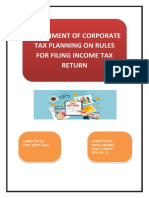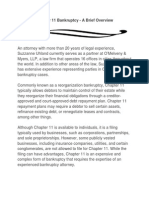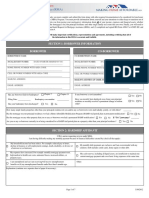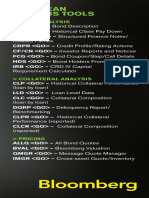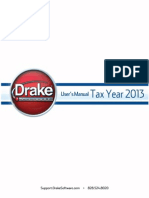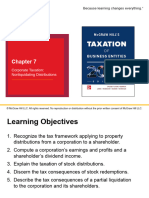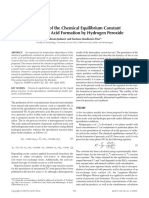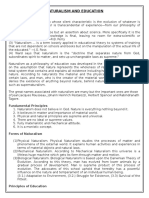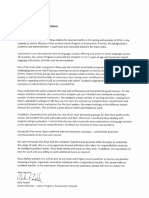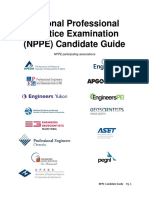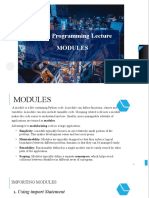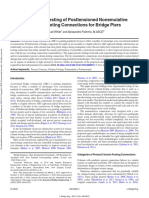Chapter 5 Corporations: Earnings & Profits and Dividend Distributions
1. Taxable Dividends
Distributions from corporate earnings and profits (E & P)
Treated as a dividend distribution, taxed as ordinary income or as preferentially taxed dividend income
Distributions in excess of E & P
Nontaxable to extent of shareholder’s basis (i.e., a return of capital)
Excess distribution over basis is capital gain
2. Calculating Earnings & Profits
E & P represents:
Upper limit on amount of dividend income recognized on corporate distributions
Corporation's economic ability to pay dividend without impairing capital
Calculation generally begins with taxable income, plus or minus certain adjustments
[1] Add previously excluded income items and certain deductions to taxable income including:
o Muni bond interest
o Excluded life insurance proceeds
o Federal income tax refunds
o Dividends received deduction
o Domestic production activities deduction
[2] Subtract certain nondeductible items:
o Nondeductible portion of meal and entertainment expenses
o Related-party losses
o Expenses incurred to produce tax-exempt income
o Federal income taxes paid
o Key employee life insurance premiums (net of increase in cash surrender value)
o Fines, penalties, and lobbying expenses
[3] Certain E & P adjustments shift effect of transaction from the year of inclusion in or deduction from taxable
income to year of economic effect, such as:
o Charitable contribution carryovers
o NOL carryovers
o Capital loss carryovers
o Gains and losses from property transactions: Generally affect E & P only to extent recognized for tax
purposes, thus, gains and losses deferred under the like-kind exchange provision and deferred involuntary
conversion gains do not affect E & P until recognized
[4] Other adjustments: Accounting methods for E & P are generally more conservative than for taxable income:
o Installment method is not permitted: recognized the gain no matter when the money is received.
o Alternative depreciation system required
o §179 expense (tangible depreciable personalty 250,000/125,000, limitation, over 800,000) must be deducted
over 5 years, so add back 80%, 60%, 40%, 20%.
o Percentage of completion must be used (no completed contract method)
o Not allow the amortization of organizational expenses
o LIFO vs. FIFO?
� o E & P rules also specify that intangible drilling costs and mine exploration and development costs be
amortized over a period of 60 months and 120 months, respectively, which are deducted in the current year.
3. Current vs Accumulated E & P
[1] Current E & P: Taxable income as adjusted
[2] Accumulated E & P: Total of all prior years’ current E & P (since February 28, 1913) reduced by
distributions from E & P
[3] Distinction between current and accumulated E & P is important
o Taxability of corporate distributions depends on how current and accumulated E & P are allocated to each
distribution made during year
4. Allocating E & P to Distributions
[1] If positive balance in both current and accumulated E&P, distributions are deemed made first from current
E&P, then accumulated E&P
o If distributions exceed current E&P, must allocate current and accumulated E & P to each distribution
o Allocate current E&P pro rata (using dollar amounts) to each distribution; apply accumulated E&P in
chronological order, beginning with the earliest distribution
[2] If current E&P is positive and accumulated E&P has a deficit, accumulated E&P IS NOT netted against
current E&P
o Distribution is deemed to be taxable dividend to extent of positive current E&P balance
[3] If accumulated E&P is positive and current E&P is a deficit, net both at date of distribution
o If balance is zero or a deficit, distribution is a return of capital
o If balance is positive, distribution is a dividend to the extent of the balance
[4] Any current E&P loss is allocated ratably during the year unless the parties can show otherwise
5. Qualified Dividends
[1] For individual taxpayers, qualified dividends are subject to a max 15% tax rate
o Beginning in 2008, qualified dividends are exempt from tax for taxpayers in the 10% or 15% rate brackets
o The lower rates on dividend income apply to both the regular income tax and the alternative minimum tax
[2] Corporations treat dividends as ordinary income and are permitted a dividends received deduction
[3] To qualify for lower rates, dividends must be:
o Paid by domestic or certain qualified foreign corps
o Qualified foreign corps include those traded on a U.S. stock exchange or any corp. located in a country that:
Has a comprehensive income tax treaty with the U.S.
Has an information-sharing agreement with the U.S. and
Is approved by the Treasury
o Paid on stock held > 60 days during the 121-day period beginning 60 days before the ex-dividend date
o Dividends paid to shareholders who hold both long and short positions in the stock do not qualify
[4] Qualified dividends are not considered investment income for purposes of determining the investment
interest expense deduction
o An election is available to treat qualified dividends as ordinary income (taxed at regular rates) and include
them in investment interest income
o Thus, taxpayers subject to an investment interest expense limitation must compare relative benefits of low
tax on qualifying dividends vs. increased amount of deductible investment interest expense
6. Property Dividends
[1] Effect on shareholder:
� o Amount distributed equals FMV of property
Taxable as dividend to extent of E & P
Excess is treated as return of capital to extent of basis in stock
Any remaining amount is capital gain
Reduce amount distributed by liabilities assumed by shareholder
Basis of distributed property = fair market value
[2] Effect on corporation:
o Corp. is treated as if it sold the property for fair market value
Corp. recognizes gain, but not loss
o If distributed property is subject to a liability in excess of basis
Fair market value is treated as not being less than the amount of the liability
[3] Effect on corporation’s E & P:
o Increases E & P for excess of FMV over basis of property distributed (i.e., gain recognized)
o Reduces E & P by FMV of property distributed (or basis, if greater) less liabilities on the property
o Distributions of cash or property cannot generate or add to a deficit in E & P
Deficits in E & P can arise only through corporate losses
7. Constructive Dividend
[1] Any economic benefit conveyed to a shareholder may be treated as a dividend for tax purposes, even though
not formally declared
o Need not be pro rata
[2] Usually arises with closely held corporations
[3] Payment may be in lieu of actual dividend and is presumed to take form for tax avoidance purposes
[4] Benefit conveyed is recharacterized as a dividend for all tax purposes
o Corporate shareholders are entitled to the dividends received deduction
o Other shareholders receive preferential tax rates
Examples of Constructive Dividends
o Shareholder use of corporate property at reduced cost or no cost (e.g., company car to non-employee
shareholder)
o Bargain sale of property to shareholder (e.g., sale for $1,000 of property worth $10,000)
o Bargain rental of corporate property
o Payments on behalf of shareholder (e.g., corporation makes payments to satisfy obligation of shareholder)
o Unreasonable compensation
o Below market interest rate loans to shareholders
o High rate interest on loans from shareholder to corporation
8. Avoiding Unreasonable Compensation
Documentation of the following attributes will help support payments made to an employee-shareholder:
o Employee’s qualifications
o Comparison of salaries with dividends made in past
o Comparable salaries for similar positions in same industry
o Nature and scope of employee’s work
o Size and complexity of business
o Corporation’s salary policy for other employees
9. Stock Dividends
� [1] Excluded from income if pro rata distribution of stock, or stock rights, paid on common stock
o Five exceptions to nontaxable treatment deal with various disproportionate distribution situations
[2] Effect on E & P
o If nontaxable, E & P is not reduced
o If taxable, treat as any other taxable property distribution
[3] Basis of stock received
If nontaxable
o If shares received are identical to shares previously owned, basis = (cost of old shares/total number of
shares)
o If shares received are not identical, allocate basis of old stock between old and new shares based on relative
fair market value
o Holding period includes holding period of formerly held stock
If taxable, basis of new shares received is fair market value
o Holding period starts on date of receipt
10. Stock Rights : Tax treatment of stock rights is same as for stock dividends
[1] If stock rights are taxable
Income recognized = fair market value of stock rights received
Basis = fair market value of stock rights
If exercised, holding period begins on date rights are exercised
Basis of new stock = basis of rights plus any other consideration given
[2] If stock rights are nontaxable
If value of rights received < 15% of value of old stock, basis in rights = 0
Election is available which allows allocation of some of basis of formerly held stock to rights
If value of rights is 15% or more of value of old stock, and rights are exercised or sold, must allocate some of basis in
formerly held stock to rights
11. Corporate Distribution Planning
[1] Maintain ongoing records of E & P:
o Ensures return of capital is not taxed as dividend
o No statute of limitations on E & P, so IRS can redetermine at any time
Accurate records minimize this possibility
[2] Adjust timing of distribution to optimize tax treatment:
o If accumulated E & P deficit and current E & P loss, make distribution by end of tax year to achieve return
of capital
o If current E & P is likely, make distribution at beginning of next year to defer taxation
12. Avoiding Constructive Dividends
[1] Structure transactions on “arms’ length” basis:
Reasonable rent, compensation, interest rates, etc...
[2] Use mix of techniques to “bail out” corporate earnings such as:
Shareholder loans to corporation
Salaries to shareholder-employee
Rent property to corporation
Pay some dividends
Overdoing any one technique may attract attention of IRS
